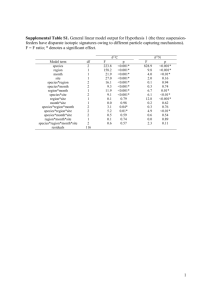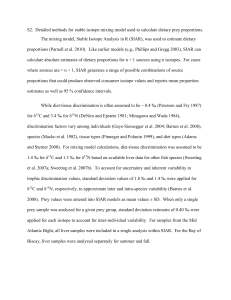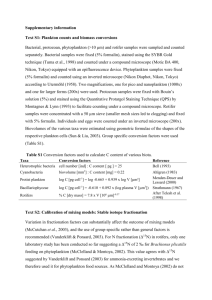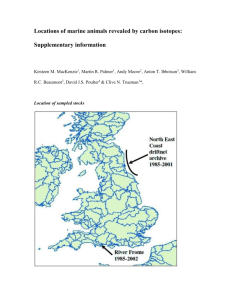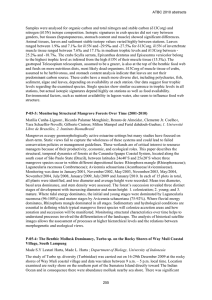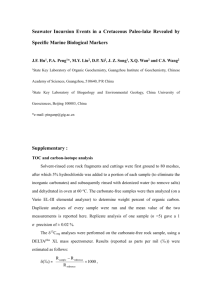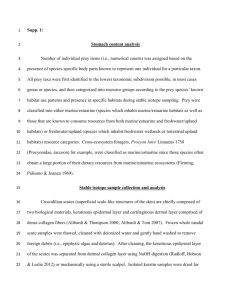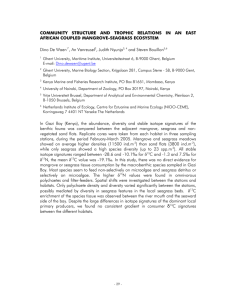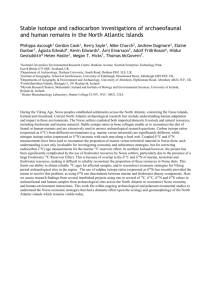δ C versus N of co-occurring molluscs within a community NOTE
advertisement
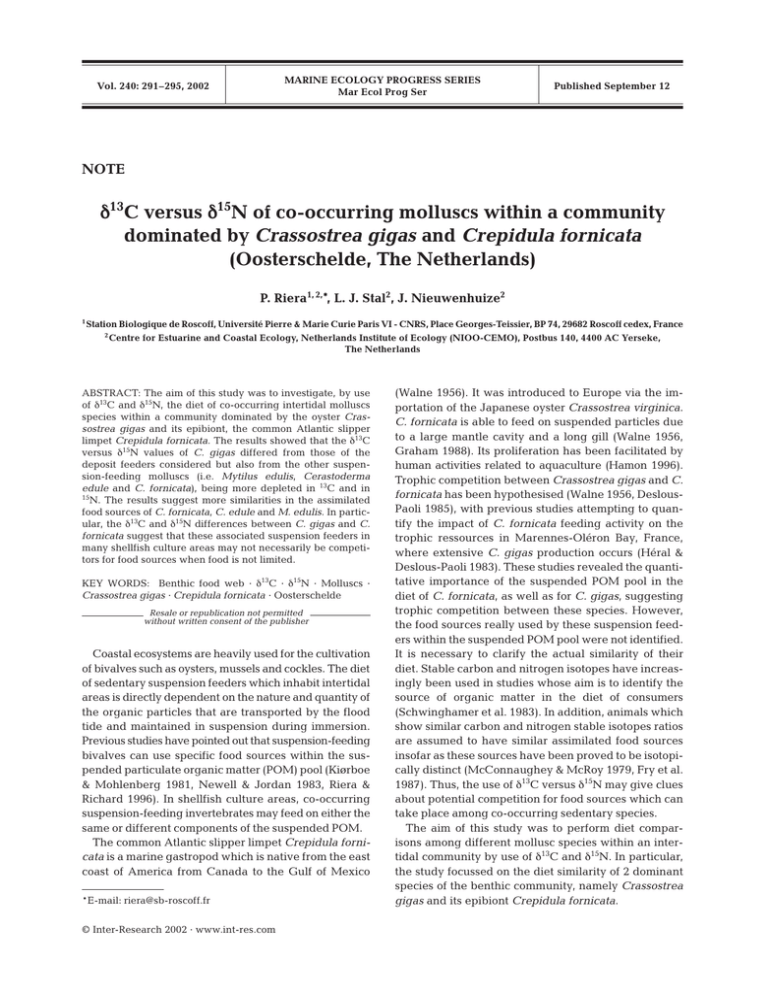
MARINE ECOLOGY PROGRESS SERIES Mar Ecol Prog Ser Vol. 240: 291–295, 2002 Published September 12 NOTE δ13C versus δ15N of co-occurring molluscs within a community dominated by Crassostrea gigas and Crepidula fornicata (Oosterschelde, The Netherlands) P. Riera1, 2,*, L. J. Stal2, J. Nieuwenhuize2 1 Station Biologique de Roscoff, Université Pierre & Marie Curie Paris VI - CNRS, Place Georges-Teissier, BP 74, 29682 Roscoff cedex, France 2 Centre for Estuarine and Coastal Ecology, Netherlands Institute of Ecology (NIOO-CEMO), Postbus 140, 4400 AC Yerseke, The Netherlands ABSTRACT: The aim of this study was to investigate, by use of δ13C and δ15N, the diet of co-occurring intertidal molluscs species within a community dominated by the oyster Crassostrea gigas and its epibiont, the common Atlantic slipper limpet Crepidula fornicata. The results showed that the δ13C versus δ15N values of C. gigas differed from those of the deposit feeders considered but also from the other suspension-feeding molluscs (i.e. Mytilus edulis, Cerastoderma edule and C. fornicata), being more depleted in 13C and in 15 N. The results suggest more similarities in the assimilated food sources of C. fornicata, C. edule and M. edulis. In particular, the δ13C and δ15N differences between C. gigas and C. fornicata suggest that these associated suspension feeders in many shellfish culture areas may not necessarily be competitors for food sources when food is not limited. KEY WORDS: Benthic food web · δ13C · δ15N · Molluscs · Crassostrea gigas · Crepidula fornicata · Oosterschelde Resale or republication not permitted without written consent of the publisher Coastal ecosystems are heavily used for the cultivation of bivalves such as oysters, mussels and cockles. The diet of sedentary suspension feeders which inhabit intertidal areas is directly dependent on the nature and quantity of the organic particles that are transported by the flood tide and maintained in suspension during immersion. Previous studies have pointed out that suspension-feeding bivalves can use specific food sources within the suspended particulate organic matter (POM) pool (Kiørboe & Mohlenberg 1981, Newell & Jordan 1983, Riera & Richard 1996). In shellfish culture areas, co-occurring suspension-feeding invertebrates may feed on either the same or different components of the suspended POM. The common Atlantic slipper limpet Crepidula fornicata is a marine gastropod which is native from the east coast of America from Canada to the Gulf of Mexico *E-mail: riera@sb-roscoff.fr © Inter-Research 2002 · www.int-res.com (Walne 1956). It was introduced to Europe via the importation of the Japanese oyster Crassostrea virginica. C. fornicata is able to feed on suspended particles due to a large mantle cavity and a long gill (Walne 1956, Graham 1988). Its proliferation has been facilitated by human activities related to aquaculture (Hamon 1996). Trophic competition between Crassostrea gigas and C. fornicata has been hypothesised (Walne 1956, DeslousPaoli 1985), with previous studies attempting to quantify the impact of C. fornicata feeding activity on the trophic ressources in Marennes-Oléron Bay, France, where extensive C. gigas production occurs (Héral & Deslous-Paoli 1983). These studies revealed the quantitative importance of the suspended POM pool in the diet of C. fornicata, as well as for C. gigas, suggesting trophic competition between these species. However, the food sources really used by these suspension feeders within the suspended POM pool were not identified. It is necessary to clarify the actual similarity of their diet. Stable carbon and nitrogen isotopes have increasingly been used in studies whose aim is to identify the source of organic matter in the diet of consumers (Schwinghamer et al. 1983). In addition, animals which show similar carbon and nitrogen stable isotopes ratios are assumed to have similar assimilated food sources insofar as these sources have been proved to be isotopically distinct (McConnaughey & McRoy 1979, Fry et al. 1987). Thus, the use of δ13C versus δ15N may give clues about potential competition for food sources which can take place among co-occurring sedentary species. The aim of this study was to perform diet comparisons among different mollusc species within an intertidal community by use of δ13C and δ15N. In particular, the study focussed on the diet similarity of 2 dominant species of the benthic community, namely Crassostrea gigas and its epibiont Crepidula fornicata. 292 Mar Ecol Prog Ser 240: 291–295, 2002 Data collection and preparation. The Oosterschelde estuary, The Netherlands, was modified during the period 1979–1986, when a storm-surge barrier was built in the seaward entrance of this estuary. Ever since, it has been disconnected from river inputs by the construction of 2 large auxiliary compartment dams at the rear end of the system. Hence, the freshwater inputs from the Scheldt, Rhine and Meuse rivers discharge mainly into the Westerchelde (Nienhuis & Smaal 1994). As a result, the Oosterschelde changed from a turbid estuary into a tidal bay. Following the reduction of tidal current velocities in the Oosterschelde, the abundance of Crepidula fornicata increased (Kluijver & Leewis 1994). The sampling station was located at Yerseke on the border of the Oosterschelde (51° 29’ 80” N, 4° 3’ 50” E). It consisted of an intertidal flat containing muddy sand as well as artificial rocky shores that border this tidal area. The benthic community included Crepidula fornicata, which was mostly attached to Crassostrea gigas. In a previous study that compared the δ15N between the Oosterschelde and the Westerschelde, it was demonstrated that the benthic food web of the Yerseke sampling station was not affected by anthropogenic nitrogen inputs as was the case in the Westerschelde, which forms the catchment of a densely urbanised and polluted area (Riera et al. 2000). The Oosterschelde is therefore more favorable for shellfish culture. Sampling was carried out during JanuaryFebruary 1998, May 1998 and July 1998. POM, SOM (suspended particulate and sedimented organic matter, respectively) and the main benthic primary producers and mollusc species were collected. POM was sampled by collecting 2 l bottles of water on the flats at high tide (±1 h after high tide) from a depth of about 0.5 m below the water surface. For stable isotope analyses POM was obtained by filtration on precombusted Whatman GF/F glass fiber filters within 2 h after collection. Subsequently, the membranes were acidified (1 M HCl) in order to remove carbonates, briefly rinsed with Milli-Q water, freeze-dried and kept at –20°C until analysis. Sediment samples were taken at low tide by scraping the upper 10 mm of mud, from a total surface of approximately 1 m2. For the measurements of stable isotopic ratios of the SOM, the sediment collected was acidified in a glass receptacle with 10% HCl, rinsed several times with distilled water and dried (60°C). The sediment was freeze-dried and ground using a mortar. Benthic diatoms were extracted from the sediment surface, using the method of Couch (1989), slightly modified by Riera & Richard (1996). The diatoms were then collected on previously combusted glass fiber filters, washed with 1 M HCl, briefly rinsed with Milli-Q water and freeze-dried. The filters were stored frozen (–20°C) until they were analyzed. Macroalgae, which were present on rocky substrates at the base of the dikes, were dominated by Fucus vesiculosus and Enteromorpha sp. These were collected manually, cleaned of their epibionts, washed with 1 M HCl to remove carbonates, and rinsed with Milli-Q water. They were then freeze-dried and subsequently ground to a powder using a mortar and pestle. Individuals of Crepidula fornicata and Crassostrea gigas, the dominant suspension feeders at this site, were collected by hand on the rocky substrates at low tide. Specimen of Mytilus edulis were also taken by hand on rocky substrates while Cerastoderma edule was collected on surficial intertidal sediments close to rocky substrates at the base of the dikes. Littorina littorea and L. saxatilis, which were abundant at this station, were collected on surficial sediment and rocky substrates at low tide. All individuals were cleaned of epibionts and kept alive overnight in the laboratory in filtered water from the sampling site to allow evacuation of gut contents. The organisms were killed by freezing. After dissection from the shell, the flesh was treated with 1 M HCl to remove any carbonate debris and rinsed with distilled water. The individuals were subsequently freeze-dried and ground to a powder using a mortar and pestle. Carbon and nitrogen isotope ratios were determined using a Fisons CN analyser coupled on line, via a Finnigan con-flo 2 interface, with a Finnigan Delta S mass-spectrometer. Data are expressed in the standard δ unit notation: δX = [(Rsample Rreference) – 1] × 103 where X = C (carbon) or N (nitrogen) and R = 13C/12C for carbon and 15N/14N for nitrogen, and are reported relative to the Vienna Pee Dee Belemnite standard (PDB) for carbon and to air N2 for nitrogen. Average reproducibilities based on replicate measurements for δ13C and δ15N were 0.1 and 0.13 ‰, respectively. δ13C and δ15N comparisons among co-occurring molluscs. δ13C versus δ15N (range of values) of the different sources of organic matter and the intertidal benthic invertebrates at the 3 sampling periods are presented in Table 1. From these results, the main organic matter sources in the intertidal area were clearly separated by their δ13C versus δ15N values, allowing the comparison of diets of the co-occurring molluscs of the intertidal community. The identification of food sources for the primary consumers (Fig. 1) involves a mean trophic enrichment in δ13C of 1 ‰ (DeNiro & Epstein 1978, Rau et al. 1983) and a mean trophic enrichment in δ15N of 3.5 ‰ (Minagawa & Wada 1984, Owens 1987) above primary producers. The mean δ13C versus δ15N values of the deposit feeders Littorina littorea and L. saxatilis set them apart from the suspension-feeding molluscs (i.e. Crassostrea gigas, Mytilus edulis, Cerastoderma edule, Crepidula Riera et al.: δ13C vs δ15N of co-occurring molluscs 293 Table 1. δ13C and δ15N (mean ± SD) of POM (particulate organic matter), SOM (sedimented organic matter), algae and intertidal molluscs in the Oosterschelde (The Netherlands) during winter, spring and summer 1998. n: number of individuals; –: not sampled δ13C Sources SOM POM Benthic diatoms Fucus vesiculosus Enteromorpha sp. Ulva sp. Intertidal molluscs Crepidula fornicata Crassostrea gigas Mytilus edulis Cerastoderma edule Littorina littorea Littorina saxatilis –21.8 ± 0.4 –23.2 ± 0.6 –11.3 ± 0.1 –18.5 ± 0.4 –19.3 ± 1.1 –16.2 ± 0.3 –17.3 ± 0.3 –16.6 ± 0.4 –15.9 ± 0.2 –15.0 ± 0.5 –16.0 ± 1.4 Winter δ15N 7.3 ± 0.1 1.4 ± 1.6 9.1 ± 0.2 6.3 ± 0.2 7.3 ± 1.3 10.7 ± 0.3 10.1 ± 0.1 10.9 ± 0.1 10.4 ± 0.5 12.2 ± 0.7 12.0 ± 1.2 n δ13C 3 3 2 2 4 –22.0 ± 0.1 –22.2 ± 0.1 –14.5 ± 0.2 – – 5 5 5 7 3 2 –16.3 ± 0.4 –17.7 ± 0.3 –17 –16.2 ± 0.3 –12.7 ± 0.9 – fornicata). In winter, the δ13C versus δ15N values of littorinids may probably be explained by a mixed diet including SOM and resuspended benthic diatoms (Fig. 1A). However, in spring and summer, benthic diatoms could not entirely explain the mean δ13C versus δ15N values of L. littorea. These δ13C versus δ15N values were most likely due to a mixed diet including SOM and macroalgae, namely Ulva sp. and/or Fucus vesiculosus (Fig. 1C). In addition, although their δ13C versus δ15N values were not determined, epiphytic and/or epilithic microalgae that cover the seaweeds and the rocky substrate could also contribute to the diet of littorinids (Jennings et al. 1997). The results of the present study demonstrate the ability of L. littorea to use different food sources within its habitat during the 3 sampling seasons (Kruskall-Wallis test, p = 0.09 and p = 0.06 for δ13C and δ15N, respectively). During winter and spring, the suspension-feeding invertebrates exhibited δ13C versus δ15N values suggestive of a mixed diet of benthic diatoms and suspended POM, with possible input of Fucus vesiculosus (Fig. 1A,B). However, unless it is highly fragmented, the macroalgae F. vesiculosus is not directly available to Crepidula fornicata and bivalves due to their suspension feeding mode. In any event, the δ15N values indicate that detritus derived from F. vesiculosus did not contribute significantly to the suspended POM pool (Fig. 1A), whereas benthic diatoms could represent a primary food source for intertidal bivalves (Riera & Richard 1996, Riera et al. 1999). In summer, no benthic diatoms mats were present at the sediment surface (Riera pers. obs.); the food sources assimilated by the suspensivores were mostly from the suspended POM pool (Fig. 1C). Thus, the δ13C versus δ15N values of the filter-feeding molluscs were likely to result from (1) a mixed diet including resuspended benthic diatoms and suspended POM and/or Spring δ15N – 4.2 ± 0.1 7.2 ± 0.3 – – 10.4 ± 0.3 10.2 ± 0.2 12 11.2 ± 0.7 15.4 ± 1.3 – Summer δ15N n δ13C 3 2 4 –19.2 ± 0.2 –20.9 7.8 ± 0.5 6.2 3 1 –15.3 ± 0.5 12.6 ± 0.2 2 –11.0 ± 0.2 12.3 ± 0.1 2 – –17.9 ± 0.6 –17.3 ± 0.2 –17.1 ± 0.3 –14.1 ± 0.7 – – 9.6 ± 0.5 10.6 ± 0.2 10.5 ± 0.3 13.2 ± 0.2 – 5 4 4 3 3 3 1 2 2 n (2) the utilisation of specific components of the suspended POM which included phytoplankton and detritus. Several differences in δ13C and δ15N values were observed among the co-occurring suspension-feeding species considered. In fact, Crassostrea gigas exhibited lighter δ13C than Cerastoderma edule in winter (Mann-Whitney U-test, p < 0.01), summer (p < 0.05) and spring (p = 0.08), and lighter δ15N in summer (p < 0.05) and spring (p = 0.08). In contrast, δ13C and δ15N values did not differ significantly between Crepidula fornicata and C. edule (p > 0.1 for δ13C and δ15N values in winter and spring). These results strongly suggest more similar assimilated food sources for C. fornicata and C. edule than between C. gigas and C. edule. In winter, δ13C and δ15N values of Mytilus edulis were heavier than those of C. gigas (Mann-Whitney U-test, p < 0.05) but were similar to those of C. fornicata (p > 0.1 for δ13C and δ15N). In addition, differences in isotopic signatures between C. gigas and C. fornicata were observed during winter (Mann-Whitney U-test, p < 0.01 and p < 0.05 for δ13C and δ15N, respectively) and spring (p < 0.05 for δ13C). Together, these results suggest that the assimilated food sources of C. gigas differed from those of the 3 other suspension-feeding molluscs (M. edulis, C. edule and C. fornicata). δ13C and δ15N values of Crassostrea gigas and Crepidula fornicata: implication for trophic competition studies. The intertidal community considered was largely dominated by C. gigas used as substrate shell by C. fornicata. C. fornicata has been often considered as a competitor for food with commercially important bivalves to which they are attached and, in particular, with the japanese oyster C. gigas (Walne 1956, Newell & Kofoed 1977, Deslous-Paoli 1985). In the present study, C. gigas and C. fornicata, exhibited different δ13C and δ15N signatures, indicating that they did not 294 Mar Ecol Prog Ser 240: 291–295, 2002 have the same assimilated food sources. The isotopic differences may be explained by assuming the use of L. sax L. lit the same food sources, namely benthic diatoms and 9 Benthic the suspended POM (Fig. 1A,B), but in different proEnt. 8 M. edu diatoms SOM portions and/or the assimilation of different specific C. for 7 components within the suspended POM pool. AlC. gig C. edu though no isotopic measurements were performed on 6 F. ves partitioned POM available to this suspension-feeding 5 community, significant δ13C and δ15N differences among different size classes of marine suspended POM and 4 plankton have been reported from the Woods Hole 3 Harbor (Wainright & Fry 1994) and from the northern POM 2 Baltic proper (Rolff 2000). From these studies and the present results we hypothesise that isotopic differ1 ences between the suspension-feeding invertebrates 0 are due to the preferential utilisation of different POM -24 -23 -22 -21 -20 -19 -18 -17 -16 -15 -14 -13 -12 -11 -10 size classes, as reported by Lesser et al. (1992) for B 14 Mytilus edulis, C. fornicata and Ciona intestinalis. The Spring ability of Crassostrea species to select for specific L. lit 13 organic matter components within the available sus12 pended POM pool was observed previously (Newell & Jordan 1983, Riera & Richard 1996). This ability to 11 utilise different parts of the available suspended POM 10 pool as a food source may reduce competition for M. edu 9 food between C. fornicata and C. gigas. Thus, we can C. edu hypothesise that in the presence of food limitation, Benthic diatoms 8 competition between C. gigas and C. fornicata is C. gig 7 unlikely because of diet differences. This ability may C. for also partially explain the successful proliferation of C. 6 fornicata together with C. gigas observed in several 5 POM shellfish culture areas (Blanchard 1995). 4 The temporal variation of the isotopic composition of -23 -22 -21 -20 -19 -18 -17 -16 -15 -14 -13 -12 a species can give clues about the variability of its food sources throughout the annual cycle. In this study, the C 14 F. ves absence of differences in δ13C and δ15N signatures Summer 13 Ulva of Crassostrea gigas among the 3 sampling periods 12 (Kruskall-Wallis ANOVA, p > 0.1 for δ13C and δ15N) suggests an overall stability of their food sources from 11 winter to summer 1998. Consistent with these results, L. lit 10 in coastal marine environments where no river inputs 9 occurred, C. gigas exhibited very little δ13C monthly SOM variation throughout the year due to its ability to pref8 erentially utilise benthic and/or planktonic microalgae M. edu C. edu 7 (Riera & Richard 1997). Unfortunately, no samples POM were taken in summer, but a similar temporal trend 6 10 Winter δ15N δ15N δ15N A C. gig 5 -21 -20 -19 -18 -17 -16 -15 -14 -13 -12 -11 -10 δ13C POM: Suspended particulate organic matter SOM: Sedimented organic matter Ent.: Enteromorpha sp. Ulva: Ulva sp. F. ves: Fucus vesiculosus M. edu: C. edu: C. gig: C. for: L. lit: L. sax: Mytilus edulis Cerastoderma edule Crassostrea gigas Crepidula fornicata Littorina littorea Littorina saxatilis Fig. 1. δ13C versus δ15N (mean ± SD) of intertidal molluscs corrected for trophic fractionation, compared with δ13C and δ15N of POM, SOM and the main organic matter sources in the Oostershelde (The Netherlands) during winter, spring and summer 1998. Values of 1 and 3.5 ‰ of primary consumers have been subtracted from the δ13C and δ15N values, respectively, to correct for trophic fractionation Riera et al.: δ13C vs δ15N of co-occurring molluscs may also be suggested for Crepidula fornicata, which exhibited no significant variation for δ13C and δ15N between winter and spring (Mann-Whitney U-test, p > 0.1 for δ13C and δ15N). In conclusion, the most abundant suspensionfeeding molluscs in this intertidal area assimilate different food sources from the available suspended POM pool. Crepidula fornicata is apparently not a competitor for Crassostrea gigas. These results underline the need for complementary studies to investigate the question of competitive interactions for food among intertidal communities that include commercially important bivalves. 295 Blanchard M (1995) Origine et état de la population de Crepidula fornicata (Gastropoda Prosobranchia) sur le littoral français. Haliotis 24:75–86 Couch CA (1989) Carbon and nitrogen stable isotopes of meiobenthos and their food resources. Estuar Coast Shelf Sci 28:433–441 DeNiro MJ, Epstein S (1978) Influence of diet on the distribution of carbone isotopes in animals. Geochim Cosmochim Acta 42:495–506 Deslous-Paoli JM (1985) Crepidula fornicata L.(Gastéropode) dans le bassin de Marennes-Oléron: structure, dynamique et production d’une population. Oceanol Acta 8:453–460 Fry B, Macko SA, Zieman JC (1987) Review of stable isotopic investigations of food webs in seagrass meadows. Fla Mar Res Publ 42:189–209 Graham A (1988) Molluscs: Prosobranch and Pyramidellid gastropods. In: Kermack DM, Barnes RSK (eds) Synopses of British Fauna (New Series), No. 2. E. J. Brill/Dr. W. Backhuys, p 310–312 Hamon D (1996) Peuplements benthiques des fonds meubles. Distribution de la faune benthique, distribution de la crépidule (Crepidula fornicata). In: Augris C, Hamon D (eds) Atlas thématique de l’environnement marin en baie de Saint-Brieuc (Côtes d’Armor). IFREMER, Brest, p 45–51 Héral M, Deslous-Paoli JM (1983) Valeurs énergétique de la chair de l’huître Crassostrea gigas estimée par mesures microcalorimétriques et par dosages biochimiques. Oceanol Acta 6:193–199 Jennings S, Reñones O, Morales-Nin B, Polunin NVC, Moranta J, Coll J (1997) Spatial variation in the 15N and 13 C stable isotope composition of plants, invertebrates and fishes on Mediterranean reefs: implications for the study of trophic pathways. Mar Ecol Prog Ser 146:109–116 Kiørboe T, Mohlenberg F (1981) Particle selection in suspension-feeding bivalves. Mar Ecol Prog Ser 5:291–296 Kluijver MJ, Leewis RJ (1994) Changes in the sublittoral hard substrate communities in the Oosterschelde estuary (SW Netherlands), caused by changes in the environmental parameters. Hydrobiologia 282/283:265–280 Lesser MP, Shumway SE, Cucci T, Smith J (1992) Impact of fouling organisms on mussel rope culture: interspecific competition for food among suspension-feeding invertebrates. J Expl Mar Biol Ecol 165:91–102 McConnaughey T, McRoy CP (1979) Food-web structure and the fractionation of carbon isotopes in the Bering Sea. Mar Biol 53:257–262 Minagawa M, Wada E (1984) Stepwise enrichment of 15N along food chains: further evidence and the relation between δ15N and animal age. Geochim Cosmochim Acta 48:1135–1140 Newell RIE, Jordan SJ (1983) Preferential ingestion of organic material by the american oyster Crassostrea virginica. Mar Ecol Prog Ser 13:47–53 Newell RC, Kofoed LH (1977) The energetics of suspensionfeeding in the gastropod Crepidula fornicata L. J Mar Biol Assoc UK 57:161–180 Nienhuis PH, Smaal AC (1994) The Oosterschelde estuary, a case study of a changing ecosystem: an introduction. Hydrobiologia 282/283:1–14 Owens NJP (1987) Natural variations in 15N in the marine environment. In: Blaxter JHS, Southward AJ (eds) Advances in marine biology, Vol 24. Academic Press, London, p 389–451 Rau GH, Mearns AJ, Young DR, Olson RJ, Schafer HA, Kaplan IR (1983) Animal 13C/12C correlates with trophic level in pelagic food webs. Ecology 64:1314–1318 Riera P, Richard P (1996) Isotopic determination of food sources of Crassostrea gigas along a trophic gradient in the estuarine bay of Marennes-Oléron. Estuar Coast Shelf Sci 42:347–360 Riera P, Richard P (1997) Temporal variation of δ13C in particulate organic matter and oyster Crassostrea gigas in Marennes-Oléron Bay (France): effect of freshwater inflow. Mar Ecol Prog Ser 147:105–115 Riera P, Stal LJ, Nieuwenhuize J, Richard P, Blanchard G, Gentil F (1999) Determination of food sources for benthic invertebrates in a salt marsh (Aiguillon Bay, France) by carbon and nitrogen stable isotopes: importance of locally produced sources. Mar Ecol Prog Ser 187:301–307 Riera P, Stal LJ, Nieuwenhuize J (2000) Heavy δ15N in intertidal benthic algae and invertebrates in the Scheldt estuary (The Netherlands): effect of river nitrogen inputs. Estuar Coast Shelf Sci 51:365–372 Rolff C (2000) Seasonal variation in δ13C and δ15N of size-fractionated plankton at a coastal station in the northern Baltic proper. Mar Ecol Prog Ser 203:47–65 Schwinghamer P, Tan FC, Gordon DC (1983) Stable carbon isotope studies on the pecks cove mudflat ecosystem in the Cumberland basin, Bay of Fundy. Can J Fish Aquat Sci 40 (Suppl.1):262–273 Wainright SC, Fry B (1994) Seasonal variation of the stable isotopic compositions of coastal marine plankton from Woods Hole, Massachusetts and Georges Bank. Estuaries 17:552–560 Walne PR (1956) The biology and distribution of the Slipper Limpet Crepidula fornicata in Essex rivers with notes on the distribution of the larger epibenthic invertebrates. Fish Invest Ser 2, 20(6):1–50 Editorial responsibility: Lisa Levin (Contributing Editor), La Jolla, California, USA Submitted: February 21, 2001; Accepted: July 10, 2002 Proofs received from author(s): August 26, 2002 Acknowledgements. This work was supported by the European Commission in the MAST programme, contract MAS3CT97-5039 and part of the project INTRMUD (MAS3-CT950022). We would like to thank Yvonne Maas and Céline Silva for analytical and technical assistance. This is publication 3036 of NIOO-KNAW. LITERATURE CITED
